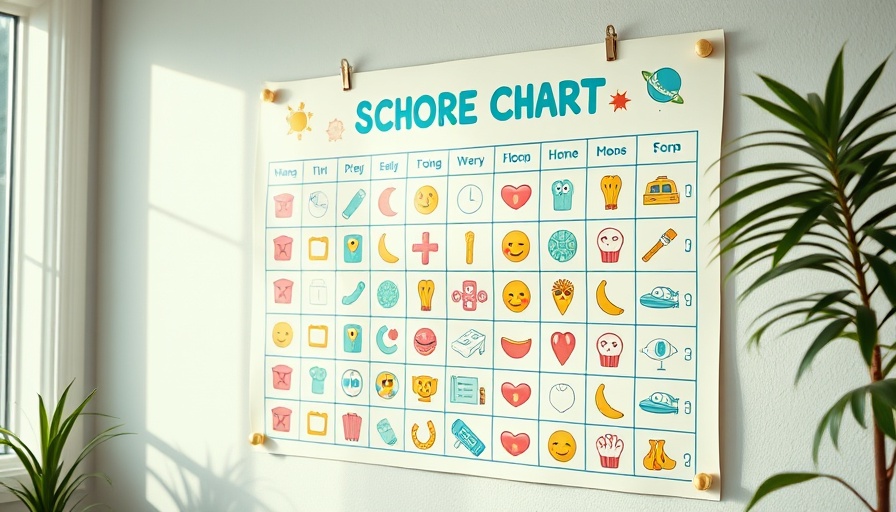Did you know that up to 70% of children with autism spectrum disorder experience anxiety when their daily routine is disrupted? This number isn’t just a statistic—it’s a daily reality for many families navigating the world of autism. Predictability might seem mundane to some, but for children with autism and their families, it can be truly life-transforming. In this comprehensive guide, we’ll explore the vital role that routine and predictability play, from fostering emotional health to supporting learning and everyday happiness. If you care about creating a calm, supportive environment for children with autism, read on to discover actionable strategies that can change lives. Unlocking Success: The Impact of Routine on Children with Autism The power of routine and predictability for children with autism cannot be overstated. Many children with autism spectrum disorder find comfort in familiar patterns. Disruptions in routine can lead to heightened anxiety, stress, and even behavioral challenges that affect the entire household. By introducing and maintaining predictable routines, parents and caregivers can provide the sense of stability children with autism so deeply crave. Daily activities such as getting ready for school, mealtimes, or transitioning to bedtime can feel overwhelming without structure. Research shows that children with ASD who follow a consistent routine exhibit improved adaptability, reduced anxiety, and better social and communication skills, making each day smoother for both children and parents. Furthermore, evidence-based approaches like ABA therapy highlight the significance of repetition and consistency in helping children with autism develop critical life skills. Ultimately, when families implement structured routines tailored to individual needs, it transforms daily life. Small steps—like using a visual schedule or preparing for transitions in advance—add up to remarkable improvements in a child’s ability to participate in, and enjoy, daily experiences. While establishing routines is essential, integrating mindfulness techniques can further support children with autism in managing transitions and emotional responses. For practical guidance on using mindfulness to foster calm and resilience, explore this meditation guide for transforming stress into self-trust , which offers accessible strategies that can benefit both children and caregivers. Did you know that up to 70% of children with autism spectrum disorder experience anxiety when their daily routine is disrupted? Understanding the power of routine and predictability for children with autism can transform not only their daily life, but also their emotional health, learning, and overall development. Why Understanding the Power of Routine and Predictability for Children with Autism is Essential Daily Life with Autism Spectrum Disorder: Navigating Challenges through Consistent Routine The day-to-day life of children with autism spectrum disorder can be unpredictable and overwhelming. The neural differences that are a hallmark of ASD often make transitions, changes, and surprises particularly difficult. Consistent daily routines help ease these challenges by offering a reliable framework that children can anticipate, reducing the uncertainty that leads to stress and anxiety. By structuring daily activities—like meals, learning, chores, and even relaxation—children with autism gain the ability to predict what happens next. Routines create a sense of control in a world that can otherwise feel chaotic, empowering children to better engage with daily living and thrive amidst the demands of school, therapy, and at-home life. Caregivers and educators alike observe that routines play a significant role in supporting the social, academic, and emotional growth of children with ASD. How Predictability Enhances a Sense of Security for Children with ASD A sense of security is a basic need, particularly for children with autism. Predictability in daily life helps children feel safe and grounded, minimizing the constant stress that comes from not knowing what to expect. When children recognize what each part of the day will bring, they are less likely to feel defenseless or overwhelmed. Predictable routines also serve as a language children with ASD understand intuitively—much more so than abstract instructions or verbal cues alone. Visual schedules and repeated sequences of tasks can provide both reassurance and confidence, giving children the foundation they need to manage transitions, develop emotional health, and achieve greater independence. What You'll Learn Why routines play a vital role for children with autism spectrum disorder Evidence-based benefits of daily routines for reducing anxiety and supporting emotional health How to implement visual supports and visual schedules in creating structured routines Practical strategies for establishing, maintaining, and adapting consistent routines for children with autism Exploring the Science: The Role of Predictability in Autism Spectrum Disorder Why Predictability Matters for Individuals with Autism Predictability goes far beyond keeping a calendar or following a checklist. For individuals with autism , the world is often filled with sensory and social information that is difficult to process quickly. A predictable routine reduces the cognitive load and anxiety that come from constant change, allowing children to focus more energy on learning, communication, and social interaction. Strong research supports the connection between predictability and positive outcomes for children with ASD. Predictable routines help bridge the gap between home and school, making it easier for children to move between environments without distress. When children know what to expect from their daily routine , they can participate more fully, develop critical skills, and build the confidence needed for independence. Research and Data: How Routines Impact Daily Activities and Reducing Anxiety Numerous studies confirm that establishing routines can significantly reduce anxiety and behavioral challenges for children with ASD. Findings indicate that structured environments, supported by visual schedules and consistent patterns, lead to fewer meltdowns, improved focus, and more positive participation in activities such as schoolwork, therapy, and play. Additionally, routines make it easier to introduce new skills and habits by building them into familiar patterns. When routines are predictable, transitions are smoother—helping children move from one activity to another with less resistance and stress. Parent and therapist observations further support the idea that a well-crafted routine is essential in reducing the overwhelming nature of daily life for children on the autism spectrum. "Routine is essential for children with autism—it’s not just about structure. It’s about helping them find calm and confidence in a world that often feels unpredictable." – Leading Developmental Pediatrician The Building Blocks: Creating Effective Daily Routine for Children with Autism Key Components of a Structured Routine: Visual Schedules and Visual Supports At the heart of a successful structured routine for children with autism are visual schedules and visual supports . These tools translate routines into meaningful, accessible steps, using pictures, symbols, or written words depending on a child’s age and abilities. Visual schedules provide clear, step-by-step guides for daily tasks such as getting dressed, brushing teeth, completing homework, and preparing for bed. Consistent use of visual aids helps children anticipate what’s next and prepares them for transitions. This predictability reduces anxiety and encourages independence, as children can refer to these visual cues on their own rather than relying only on verbal reminders. For many families and educators, visual schedules are the key that unlocks a child’s ability to participate confidently in their routine. Using Daily Activities to Support Social and Communication Skills Regular daily activities , when structured within a clear routine, offer rich opportunities for the development of both social interaction and communication skills. Routines such as family mealtimes, playdates, and bedtime storytelling encourage turn-taking, conversation, and the use of expressive language. As children become more comfortable with each routine, they often become more willing to interact, ask questions, and engage with the people around them. Parents and therapists can enhance these benefits by consciously building communication goals into routines. For example, a bedtime routine might include asking a child to choose a story or say goodnight—promoting both social and verbal engagement. Structured routines also allow children with ASD to practice social rules in a context that feels safe and predictable, making generalization of these skills much easier. Sample Daily Routine vs. Unpredictable Day: Effects on Children's Behavior, Stress, and Participation Structured Daily Routine Unpredictable Day Behavior Calmer, fewer meltdowns, increased cooperation More frequent outbursts, resistance to new tasks Stress Levels Lower anxiety, improved self-regulation Heightened anxiety, difficulty calming down Participation Actively involved in routines, greater independence Reluctance to join activities, withdrawal or avoidance Practical Implementation: How to Establish and Maintain Routines Play for Children with ASD First Steps: How to Introduce Visual Schedules and Consistency Starting with small, consistent changes is the best way to introduce routines for children with autism spectrum disorder. Begin by selecting key activities that occur daily, such as morning routines or mealtimes, and create a simple visual schedule using pictures, charts or icons that your child understands. Involve your child in assembling the schedule or choosing icons to encourage ownership and engagement. Establish regular times for these activities and use the visual supports to guide transitions. Consistently refer to the visual schedule, gently prompting your child to use it before each step. Over time, as children become familiar with these patterns, you can gradually introduce new elements to the routine without causing overwhelm. Keeping routines predictable and reinforcing them with praise and encouragement will make the process smoother and more enjoyable for everyone. Bedtime Routine and Transition Times: Tips for Success Bedtime routines are particularly important for children with ASD, as the transition to sleep can be fraught with anxiety and sensory sensitivities. Create a calming, step-by-step process—such as a visual schedule for pajamas, teeth brushing, and story time—to make each phase of the evening predictable. Provide verbal or tactile cues (e.g., dimming lights) to signal that bedtime is approaching and use a soothing tone to reduce overstimulation. During other daily transitions (e.g., moving from play to mealtime), keep language simple and consistent, offer warnings before changes, and acknowledge emotions that might arise. Children benefit greatly from positive reinforcement and gradual adjustments to new routines. Over time, what begins as structured support becomes a comfortable part of your child’s lexicon of daily living. Set clear expectations for daily life transitions Keep routines simple and easy to follow Use visual supports such as calendars and charts Reinforce positive routines with praise and rewards Anticipate changes by preparing your child in advance Therapeutic Approaches: How ABA Therapy Supports Daily Routines and Predictability ABA Techniques for Structuring Routine in Children with Autism ABA therapy (Applied Behavior Analysis) is one of the most widely respected approaches for supporting children with autism in building and maintaining effective daily routines. ABA therapists use methods like task analysis—breaking down complex routines into manageable steps—and positive reinforcement to help children develop independence and mastery over daily tasks. Structured routines introduced in therapy are consistently practiced at home and in school, ensuring that the child experiences a seamless sense of predictability across environments. Visual supports, schedules, and clear cues are common ABA tools that not only facilitate learning but also empower children to navigate transitions and challenges with confidence. Collaboration with Therapists and Caregivers for Daily Routine Consistency Consistency between caregivers, teachers, and therapists is vital in maximizing the benefits of established routines. Open communication ensures that strategies used in one environment are reinforced elsewhere, creating a structured environment where children know what to expect no matter where they are. Regular meetings and shared documentation—such as visual schedules, progress logs, or communication journals—keep everyone aligned on goals and challenges. By uniting around the principle of routine, care teams can support children with autism in achieving stability and growth at every stage of development. "A consistent routine, supported by ABA principles, can provide children with ASD the predictability they need to thrive at home and at school." – Board Certified Behavior Analyst Adapting Daily Routines: Meeting the Unique Needs of Each Child with Autism Spectrum Disorder Personalizing Structured Routine for Diverse Preferences and Challenges Each child with autism is unique—so every daily routine must be tailored to match individual needs, preferences, and sensitivities. Some children might benefit from highly detailed visual schedules, while others require more general cues or tactile supports. Parents and caregivers should work closely with therapists to observe what works and make adjustments as their child grows or as circumstances change. Flexibility is key; while structure is important, so is adapting to the child’s evolving strengths and interests. Incorporate sensory-friendly modifications—the use of calming colors, soothing lighting, or preferred activities—into routines. The most successful routines are those that both support developmental progress and honor each child’s personality and comfort level. Tools and Technology: Leveraging Visual Schedules and Supports Digitally Today, technology offers creative solutions for building structured routines. Digital apps provide customizable visual supports, easy-to-modify visual schedules, and reminders that both parents and children can access on tablets or smartphones. Apps can often be color-coded or enhanced with audio cues to match sensory preferences, making routines more engaging and accessible. For families who prefer tangible aids, printable schedules and color-coded charts remain invaluable. Many children respond well to blending digital and physical supports, such as interactive tablets paired with magnet boards. The key is to experiment and discover which tools foster the greatest sense of predictability and independence for your child. Digital apps for visual supports Customizable printable schedules Color-coded routines for clarity Sensory-friendly modifications Case Studies: Transforming the Daily Life of Children with Autism through Predictable Routines Success Story: From Chaos to Calm with Daily Routines Six-year-old Alex struggled with meltdowns and frequent anxiety until his parents and therapists decided to implement a visual schedule for every key daily activity. Step by step, Alex learned what to expect—first breakfast, then playtime, then schoolwork—and his confidence soared. Not only did his anxiety decline, but he also began initiating more conversations and taking pride in his small victories throughout the day. By using routines as anchors and allowing choice within those structures, Alex’s family saw improvements in both his social skills and emotional regulation. His school embraced a similar approach, reinforcing routines and confidence across home and classroom. Family Insights: How Visual Supports Changed Our Child with Autism’s World One parent shares, “Before we started using visual schedules, every morning was a battle. With pictures and charts, our son knows exactly what comes next. We no longer face tears before school, and even transitions he used to dread now bring smiles. Simple routines have truly changed his world—and ours.” Countless families report similar results: fewer meltdowns, more meaningful family connections, and greater independence for their children. Every small step toward predictability creates a ripple effect, leading to more confident, resilient children ready to take on the challenges of daily life. "Since using a structured routine and visual schedules, our child’s anxiety has dropped dramatically, and his participation in daily activities has increased." – Parent of a Child with ASD Emotional Health and Reducing Anxiety: The Psychological Benefits of Routine for Children with Autism How Daily Routines Foster Emotional Health and Self-Regulation Daily routines do more than organize a child’s day—they create a foundation for emotional health and self-regulation. With predictable expectations and clear steps, children with autism can manage their emotions during difficult transitions. Regular structure gives them the security needed to face the unexpected and use learned coping strategies. Over time, routines foster a sense of accomplishment and self-efficacy. Children who understand their daily rhythm are more able to self-soothe, adapt to change, and rebound from upsets with less distress. Self-regulation strategies—like deep breathing or using a favorite fidget—are easier to implement when embedded naturally into the daily routine. Reducing Anxiety in Daily Life: Practical Insights for Children with ASD Reducing anxiety in children with ASD isn’t about removing every challenge, but rather equipping children to manage uncertainty. Well-established routines give children reliable tools for success. Predictability takes the edge off transitions, allowing room for joy, learning, and connection. Strategies like previewing the day, using countdown timers, and giving advance notice for changes help children process new experiences without feeling overwhelmed. Over time, the positive experiences gained through routine build resilience, making future changes less daunting. Recognizing Warning Signs and Supporting Emotional Health Caregivers should stay alert for signs that a child may be struggling with changes in routine: increased irritability, avoidance, sleep difficulties, or withdrawal can all indicate rising stress. When these warning signs appear, revisit the routine and work collaboratively to restore a sense of stability. Consistent check-ins, open communication, and celebrating small successes are all vital for maintaining emotional health. At its best, a routine is a living framework—always evolving to support growth and foster well-being. Parent Strategies: Supporting and Adapting Routines for Your Child with Autism Overcoming Obstacles to Maintaining Consistent Routine Life is unpredictable, and even the best routines will face disruptions—from travel and family events to illness or unexpected school changes. By proactively discussing possible changes and involving the child in problem-solving, parents can help children accept small deviations while maintaining overall structure. If routines go off track, return to basics: reinforce visual supports, reestablish regular routines, and use reassuring language. Collaboration between caregivers, teachers, and therapists ensures everyone is using similar strategies—making it easier for the child to regain their sense of stability . Building Flexibility into Predictable Daily Routines While consistency is critical, children with autism also benefit from learning how to handle changes within predictable routines. Flexibility can be introduced gradually: swapping out a single step in a daily sequence, offering choices within the structure, or rehearsing changes in advance. Celebrate adaptability and create opportunities for safe exploration of new experiences. When flexibility is part of the routine itself, children gain the confidence and tools needed to navigate daily life with resilience and optimism. Monitor for signs of discomfort or confusion Gradually introduce and reinforce new routines Communicate clear expectations Involve the child’s input in planning People Also Ask Why is predictability important in autism? Predictability provides a sense of security for children with autism, reduces anxiety, and helps them anticipate what comes next in daily life, making transitions less challenging. Why is routine important for autistic children? Routine establishes structure in daily activities for children with ASD, promoting emotional health and making learning, play, and social interactions more manageable. Why are predictable routines important for children? Predictable routines give all children, especially those with autism spectrum disorder, stability and confidence. They also support behavior regulation and emotional development. What is the 6 second rule for autism? The 6 second rule suggests waiting six seconds after prompting a child with autism before repeating instructions. This allows processing time crucial for children with ASD. Frequently Asked Questions on the Power of Routine and Predictability for Children with Autism How can parents start implementing structured routine at home? Start small by choosing one or two key daily activities, such as morning or bedtime routines, and introduce a simple visual schedule. Use consistent timing, reinforce routines with praise, and gradually add more steps as your child becomes comfortable with the pattern. What are the best visual supports for children with ASD? The most effective visual supports are personalized to your child’s strengths—these can include painted or drawn charts, picture schedules, magnetic boards, or digital apps that display the daily routine using images and symbols the child understands. How do daily routines change as children grow? As children develop, routines should evolve to reflect new responsibilities, preferences, and life stages. Involving your child in the planning and adjusting routines to include age-appropriate goals fosters independence and confidence. When should parents seek professional help for routine disruptions? If you observe persistent distress, meltdowns, or difficulties adjusting to new routines despite consistent strategies, consult your child’s therapist, ABA provider, or pediatrician. Professionals can help tailor routines and provide guidance for overcoming unique challenges. Learn More: Recommended Resources and Video Guidance on Structured Routines for Children with Autism Watch: How to Create a Visual Schedule for Your Child with Autism Discover step-by-step techniques for building and customizing visual schedules, including selecting appropriate images, introducing schedules to your child, and reinforcing daily use. Watch: Real Parent Stories—Transforming Daily Routines through Predictability Hear from parents who have implemented structured routines and visual aids, sharing both challenges and the positive changes they’ve seen in their children’s lives. Watch: ABA Therapy in Action—Using Consistency to Promote Success See ABA therapists and families demonstrate consistency, reinforcement, and the integration of new skills into daily routines for children with autism spectrum disorder. Instructional video demonstrating a parent and therapist together creating and using a visual schedule with a child with autism in a home environment; clear close-up shots, professional step-by-step guidance, and visible support tools. No background music, clear narration describing each action. Summary: Maximizing the Power of Routine and Predictability for Children with Autism Routine and predictability can be life-changing for children with ASD, offering emotional support, reducing anxiety, and leading to developmental gains. Implementing daily schedules using visual supports and simple strategies can promote a sense of security and success in the home and school. If you’re inspired to deepen your understanding of how daily habits and self-care routines can support well-being at every stage of life, consider exploring broader strategies for thriving. Our guide on top health tips for thriving after 45 offers valuable insights into building resilience, maintaining emotional balance, and fostering lifelong wellness. Whether you’re supporting a child with autism or seeking to enhance your own daily routine, these holistic approaches can help you create a more balanced, fulfilling life for your entire family. Establishing consistent routines is crucial for children with autism, as it provides predictability and structure that can significantly reduce anxiety and improve behavior. For instance, the Phoenix Autism Center emphasizes that a predictable routine helps children feel safe and in control, minimizing stress and enhancing their ability to focus on tasks. ( phoenixautism.com ) Incorporating visual schedules into daily routines can further support children with autism by offering clear, visual cues about what to expect next, thereby easing transitions between activities. Autism Learn & Play Inc. highlights that visual schedules provide a visual representation of daily tasks, helping children better understand the sequence of activities and reducing anxiety. ( autismlearnplay.org ) By integrating these strategies, caregivers can create a supportive environment that fosters emotional stability and promotes skill development in children with autism.

 Add Row
Add Row 

 Add
Add 


Write A Comment